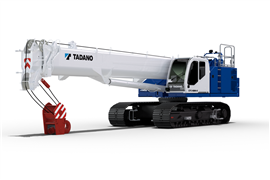Coverage limited?
08 April 2013
In most Construction Contracts and Master Service Agreements (in the oil and gas industry), there is an Insurance Requirements provision. In this provision, the upstream contractors often specify that your GL policy must contain Products Completed Operations (“Completed Operations”) coverage for both you and the companies you name as Additional Insureds. What is this coverage? How does it impact you?
Completed operations coverage pays for damages that occur after your work is completed at the jobsite. However, crane companies don’t usually have much Completed Operations exposure. Why? Unlike other subcontractors at the jobsite, a crane company doesn’t typically build something and leave a product behind. Thus, even though a GL policy has coverage, very seldom does a GL carrier pay for damages arising from a crane company’s own Completed Operations.
In contrast, upstream contractors like steel erectors and general contractors have significant Completed Operations exposure. Why should this matter to you? If you name any of these upstream contractors as an Additional Insured (“AI”) on your policy, and your policy has form CG 2037, your GL policy might be stuck paying for their Completed Operations exposure. And, for these types of upstream contractors, Completed Operations exposure is typified in construction defect claims – which are very expensive to defend and just as costly to settle.
There are various edition dates of the CG 2037 policy form. On your Schedule of Forms and Endorsements in your policy, look for a form entitled “Additional Insured – Owners, Lessees or Contractors – Completed Operations.” Then see which edition date you have. With each edition date, the trigger language effects when a Named Insured’s policy would provide Completed Operations coverage to an Additional Insured. For each form, the trigger language is underlined below.
- CG 2037 (10/01) – only with respect to liability arising out of the Named Insured’s work
- CG 2037 (07/04) – only with respect to liability caused in whole or in part by the Named Insured’s Work
As discussed in the article about “arising out of” status a few months ago, courts across the country have broadly interpreted the phrase “arising out of.”
- If your GL policy has the CG 2037 (10/01) Additional Insured form – with the “arising out of” trigger, your mere presence on the jobsite is likely enough to cause your GL carrier to defend and perhaps settle a Completed Operations claim on behalf of the upstream contractor who is an Additional Insured on your GL policy.
- In contrast, the CG 2037 (07/04) Additional Insured form uses the trigger words of “caused in whole or in part.” If your policy has this edition date, your company must have played a role in causing the accident before a GL or Excess carrier should settle a Completed Operations (commonly known as a construction defect) claim on behalf of an upstream contractor who is an Additional Insured. Your GL carrier may have a duty to defend the claim, depending upon what is alleged in the lawsuit. But, at a minimum, with the (07/04) edition, the carrier is in a better position to fight picking up a tender and paying a claim when you are not at fault.
Let’s look at a few real life accidents to see how this plays out when you provide a manned mobile crane pursuant to a Master Contract, and you have agreed to provide Completed Operations coverage with the CG2037 Additional Insured form on your GL policy:
Accident #1: Parking garage collapse
The GC hired you to fly in tilt walls, girders, etc. for construction of a parking garage. One year after your work is completed, the garage collapses causing over $100 million in total damages. Clearly, the crane did not cause this accident, and rather it was improper construction methods that caused its collapse. But, when the general contractor and erector are sued, they tender the claim to your GL carrier.
Accident #2: Tower crane collapse
The GC hires your mobile crane to assist with the erection of a tower crane. The tower crane is erected without incident. Six months later, while the tower crane is being operated, it collapses, causing catastrophic losses in excess of $50 million in damages. During the investigation, it’s determined that the collapse was caused by an improperly designed base, which was designed by an engineering firm hired by the GC. Unfortunately, the engineers only carry $2 million in malpractice insurance. The GC is now left scrambling to find others to assist in paying the remaining $48 million in damages. The GC’s attorney sends a tender letter to your GL carrier.
Responses to the tenders
In each of the above scenarios, the crane company did not cause the accidents. Why should your GL and Excess policies pay millions of dollars to settle claims caused by others’ fault? The answer is simple. It shouldn’t if you have the proper edition date of the CG 2037 Additional Insured form. If you have the (07/04) edition date of the CG2037 Additional Insured form with “caused in whole or in part” language, your GL policy will not have to pay to settle the claim and may not have to defend the claim either. If you have the (10/01) edition date with “arising out of” language, your policy most likely will have to defend and may even have to contribute to the settlement.
The cost to defend the tower crane claim could likely reach $500,000-plus, but this is inexpensive in comparison to the cost to defend the parking garage collapse claim as that cost could easily be several million dollars.
Lessons learned
The lessons from these hypotheticals:
- Avoid giving Completed Operations coverage to any Additional Insured. Strike that requirement in the Insurance Provisions and explain to your customer that you don’t leave a product behind so you shouldn’t have to provide that coverage like subcontractors who build part of the structure.
- If you must give Completed Operations coverage for business reasons, try to avoid agreeing to the CG2037 (10/01) edition with broad “arising out of” status. Instead offer the (07/04) edition if it’s included in your GL policy.
- The terms of your contracts must match the coverage available in your policy. Ask your agent or attorney to review the Insurance and Indemnity provisions of these contracts to make sure the contract provisions match the insurance coverage provided in your policies.
Talk to your agent
Discuss with your insurance agent which edition dates of Additional Insured forms should be on your GL policy form.
For both Ongoing Operations and Completed Operations, if you want to limit exposure on your GL policy, it is better to have the July 2004 (07/04) edition of Additional Insured form so you don’t have exposure for the “arising out of” trigger.
Importantly, you must NEVER agree in a contract to provide “arising out of” coverage if you don’t have the respective AI form on your policy. This is because if you agree to a (10/01) edition date with “arising out of” status but your policy only has the (07/04) edition, you could be sued for breach of contract, and generally, your policy does not provide coverage for such claims so you will be paying these costs out of your own pocket.
Ultimately, each crane company needs to make a business decision – based on discussions with your agent, knowledge of your customers’ requirements and experience of your contract manager. You may choose to agree to different edition dates for different exposures; for example, use the (10/01) edition for Ongoing Operations but the (07/04) edition for Completed Operations. But whichever edition dates you agree to, you need to ensure you have those edition dates of the Additional Insured forms on your policy.
Helpful questions
Here are two questions to help you decide:
- If you want the ability to agree to provide “arising out of status,” do you want your GL policy paying claims and defense costs when you have no fault in causing the damages?
- Or, risk not complying with the terms of the contract that specify the (10/01) edition date, which could result in lost business or customers, and/or getting sued for breach of contract?
These are tough questions and the answers may be different for each operation. For further review, please contact NBIS at 1-877-860-RMSS or your insurance agent to assure you make the right coverage decision for your company.
Bio: Michelle Lorenz is manager of litigation and claims for NBIS.
STAY CONNECTED


Receive the information you need when you need it through our world-leading magazines, newsletters and daily briefings.
CONNECT WITH THE TEAM











